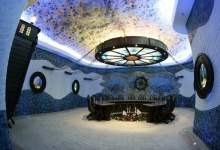
Increasingly, obsolete mines, some centuries old, are being transformed into quirky community centres and tourist attractions that utilise the unique mine atmosphere and landscape. This results in local jobs, community engagement and an improved local economy, as well as providing an insight into the ancient tradition of mining.
Wieliczka Salt Mine, Poland

Recognised as an important historical, cultural and spiritual monument, the Wieliczka Salt Mine, located in the town of Wieliczka in southern Poland, can be traced back to the 13th century. The mine, which was entered on UNESCO’s First World List of Natural and Cultural Heritage in 1978, produced salt almost continuously until 2007.
Now it houses a hotel, built in 2006, and a museum, which was established many years earlier in 1966. In 2005, more than one million visitors from all over the world visited the mine.
The mine is also considered a major hub for Polish culture, hosting music concerts, art exhibitions, cultural get-togethers and occasional events, such as bungee jumping and underground wind surfing. It has also been used as a backdrop for many TV and film projects.
Cricova Winery and Wine Cellar, Moldova

Cricova Winery and Wine Cellar is the second largest wine cellar in Moldova. It was formerly a limestone mine which dates back to the 15th century, and became famous as a hiding place for Jews in the Second World War. It was transformed into an underground wine emporium in the 1950s and is now a key tourist attraction.
The winery is 100m deep and has 120km of labyrinthine roadways, half of which are used for wine storage. Around 1.2m bottles of wine are stored at temperatures of 12 °C, which is maintained all year round. As well as being used for storage, wine is also produced here and wine tours and tastings are held. Vladimir Putin celebrated his 50th birthday at the winery.

Bounce Below, Wales
In 2014, the abandoned 176-year old Blaenau Ffestiniog’s slate mine in North Wales, which was dug out by men and boys in Victorian times, was opened as a visitor attraction centre, comprising a unique collection of layered underground bouncy nets.
A five minute train journey takes visitors down to the cavern 100ft below ground. Here, trampoline like nets are hung within two vast chambers at different levels, the highest being 180ft up from the bottom of the cavern. The trampolines are linked together by walkways and slides. Visitors can also enjoy an educational tour of the Victorian slate mine, which involves a ride on the steepest cable railway in Britain taking visitors hundreds of feet underground, while hearing about tales from Victorian mining families. A new chamber, unseen for 50 years, has recently been opened.

Salt Cathedral of Zipaquirá
The Salt Cathedral of Zipaquirá is located in a 200m deep former salt mine in a Halite mountain near the town of Zipaquirá in Cundinamarca, Colombia. The mine, which dates back to fifth century BC, is a popular tourist attraction and a place of pilgrimage for Columbians. However, it has no bishop and therefore no official status as a cathedral in Catholicism.
Miners had already constructed a sanctuary for daily prayer in the mine, however the first proper underground church was built in 1932. In 1950, construction of the bigger Salt Cathedral began and it was inaugurated in 1954. However, due to structural problems, this was shut down in 1990. In 1991, the construction of a new cathedral was undertaken, 200ft under the older one, and finished in 1995. An above-ground salt theme park covering 32ha is also located at the mine.

The Eden Project, Cornwall
The Eden Project is one of the most famous mine transformation projects in the world. The site was a former open pit Kaolinite mine that was in operation for 160 years. By the 1990s, the pit was complexly exhausted and abandoned. The idea to transform the abandoned mine into a visitor centre was conceived by Tim Smit in the mid-nineties. After two and a half years and some construction problems, the site was officially opened on 17 March 2001.
The project’s key features include a collection of geodesic biome domes, one which is tropical and houses tropical plants, such as fruiting banana trees, coffee, rubber and giant bamboo, and another which houses warm temperate and arid plants, such as olives. The Outdoor Biome (which is not covered) represents the temperate regions of the world with plants such as tea, lavender, hops, hemp and sunflowers.
The part known as The Core was opened in 2005 and is an educational centre incorporating classrooms and exhibition spaces, designed to help communicate Eden’s central message about the relationship between people and plants. In winter, the project also houses an ice rink.


.gif)

